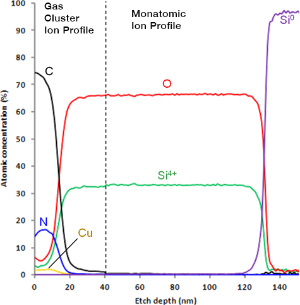Both XPS systems are capable of argon ion depth profiling, the Kratos system offers monoenergetic argon ions, whilst the Thermo k-alpha+ system is equipped with an Argon Gas Cluster Ion source (MAGCIS).
Such cluster sources are able to analyse many groups of materials previously inaccessible to conventional XPS depth profiling which induced large scale damage to the surface and subsequent changes in the surface chemistry of the analyte.
A dual mode ion source facilitates the removal of both hard and soft materials without altering the chemistry of the remaining surface. Whilst XPS systems fitted with a source producing monatomic argon ions work well for inorganic materials, gas cluster ion sources minimize the damage by reducing the energy going into the surface.
By making the argon projectile much heavier, using a weakly bound (Van der Waals’ forces) cluster of gas atoms , we can still remove material but we can spread the energy and single charge across the whole cluster. This vastly decreases the “damage zone” in the remaining surface, as there is significantly less energy imparted into the material by the cluster impact, and results in XPS spectra that accurately represent the real surface chemistry.
Multi-Mode Depth Profiling
Devices are not usually based around one type of material, but may be a mixture of organic and inorganic compounds.
Shown here, is the analysis of an organic FET showing both monatomic and gas cluster ion etching. The twin operating modes of the MAGCIS source facilitate depth profiles of both organic and inorganic materials which is The Thermo Scientific Avantage XPS data system controls simple mode switching during the experiment.
The twin operating modes of the MAGCIS source facilitate depth profiles of both organic and inorganic materials which is The Thermo Scientific Avantage XPS data system controls simple mode switching during the experiment.
The MAGCIS source performs the first part of the profile in cluster mode to preserve the sensitive organo-metallic chemistry, before changing to monatomic mode for the inorganic layer, creating a full profile of the entire device.
The MAGCIS source also allows gentle in-situ cleaning of sensitive samples such as glasses, high-k materials and inorganic oxides which enables a more accurate understanding of such ion sensitive materials.
How can it help? |
Common applications? |
|---|---|
|
|
|
|

